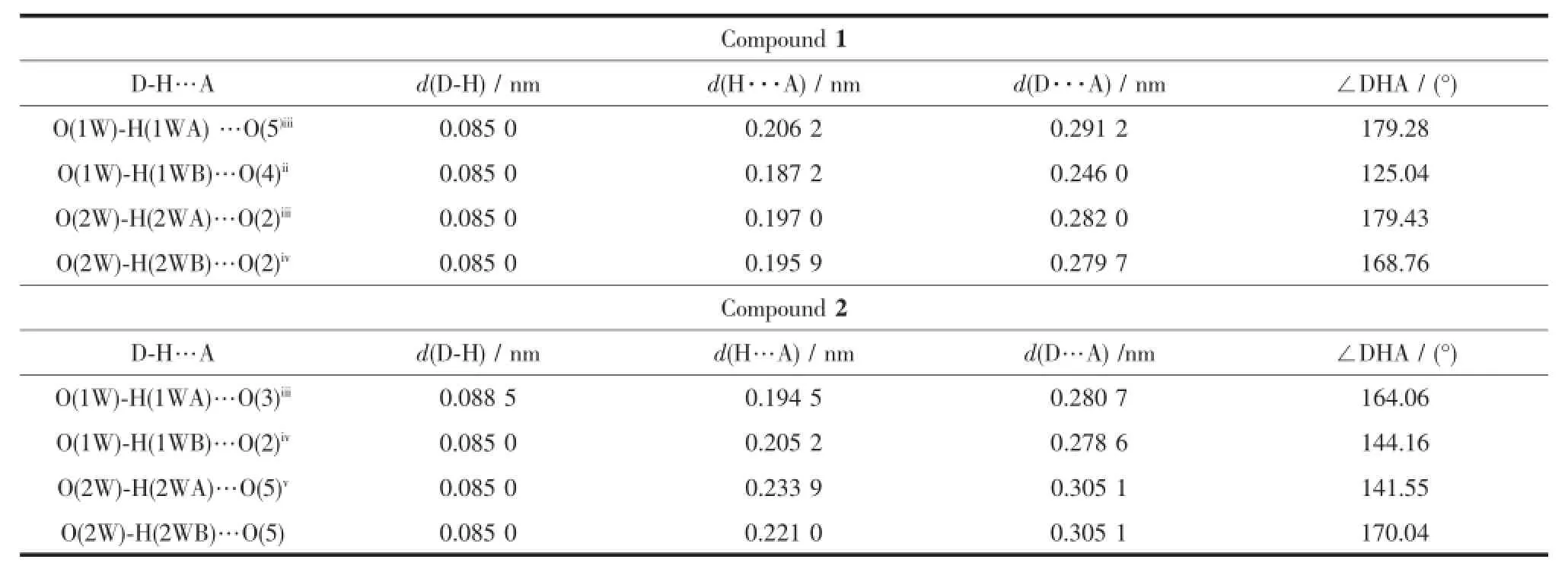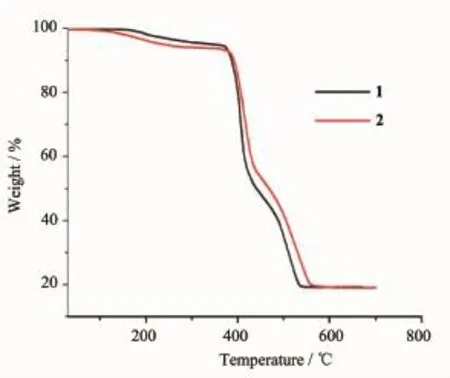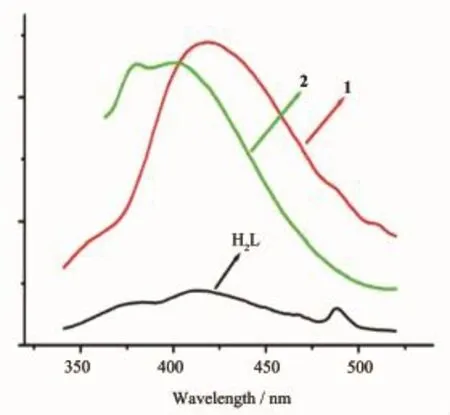基于5-(4-羟基吡啶基甲基)间苯二甲酸配体的两种Zn(Ⅱ)的配位聚合物的合成、结构和荧光性质
李付安 徐伏 杨维春 李松田
基于5-(4-羟基吡啶基甲基)间苯二甲酸配体的两种Zn(Ⅱ)的配位聚合物的合成、结构和荧光性质
李付安 徐伏 杨维春*李松田
(平顶山学院化学与环境工程学院,平顶山467000)
采用水热合成的方法,在以5-(4-羟基吡啶基甲基)间苯二甲酸(H2L)作主配体、4,4′-联吡啶(4,4′-bpy)和1,2-二(4-吡啶基)乙烯(bpe)作辅配体的条件下,得到2种新颖的Zn(Ⅱ)配位聚合物{[Zn(L)(4,4′-bpy)0.5]·2H2O}n(1)和{[Zn(L)(bpe)0.5]·2H2O}n(2)。配合物通过单晶X射线衍射的方法进行了结构分析,并进一步通过红外光谱(IR)、元素分析、PXRD和热重分析(TG)的方法进行了表征。结构分析表明配合物1展现出的是一种三维三重互穿网络;聚合物2为二维双层结构,并进一步组合成了三重平行互穿的2D→3D的空间网络。此外,研究了配合物的荧光性质。
5-(4-羟基吡啶基甲基)间苯二甲酸;聚合物;锌;互穿网络
In the past decades,the construction of novel coordination polymers has attracted the interest of chemist communities in the field of supramolecular chemistry and crystal engineering due to their novel architectures as well as potential applications[1-11].The self-assembly processes of coordination polymers can be directed by several factors:the coordination geometry of metal ions,the structural characteristics of ligands,the solvent system,and so on[12-16],among which the rational design and reasonable use of the characteristic ligand are very important in the construction ofthe desired coordination polymers[17-20].
It is well-known that organic aromatic polycarboxylate ligands are important multidentate O-donor ligands which have been concerned much in recent years because of their pluridentated and excellent coordinated ability.Up to now,coordination polymers with unusual structures and distinctive properties have been extensively assembled by combining organic aromatic polycarboxylate ligands and metalions[21-23].Recently,Sun etal.have introduced a versatile ligand,3-(4-hydroxypyridinium-1-yl) phthalic acid,and its corresponding coordination polymers with helical subunits[24-25].We chose 5-(4-hydroxypyridinium-1-ylmethyl)isophthalic acid(H2L)as a building block for the following reasons:(1)H2L possesses a flexible-CH2-spacer between the phenyl ring and pyridine ring,which makes the pyridine ring rotate freely to meet the requirements for coordination; (2)the pyridine ring and phenyl ring are twisted around the-CH2-spacer,and the skew coordination orientation of the carboxyl groups provide the potential of helices formation;(3)the functional hydroxyl groups of this ligand can actnotonly as coordination sites,butalso as side arms of interdigital architecture in incoordination mode.
To the bestof our knowledge,the architectures of coordination polymers constructed from H2L have not been investigated.In this work,by using ligand H2Land N-donor ancillary ligands,two coordination polymers, {[Zn(L)(4,4′-bpy)0.5]·2H2O}n(1),and{[Zn(L)(bpe)0.5]· 2H2O}n(2),were prepared by hydrothermal methods. Theirstructures have been determined by single-crystal X-ray diffraction analyses and further characterized by infrared spectra(IR),elementalanalyses,powder X-ray diffraction(PXRD),and thermogravimetric(TG) analyses.Their crystal structures and the systematic investigation of the effects of H2L ligand and N-donor ancillary co-ligands on the ultimate frameworks are discussed in detail.Furthermore,their fluorescence properties have also been investigated in detail.

Scheme 1 Coordination mode of the ligand H2L found in compounds 1 and 2
1 Experimental
1.1 Materials and physical measurement
All reagents and solvents employed in the presentwork were of analytical grade as obtained from commercial sources without further purification.H2L was synthesized according to the literature[26]. Elemental analysis for C,H,and N was performed on a Perkin-Elmer 240 elemental analyzer.The FTIR spectra were recorded from KBr pellets in the range from 4 000 to 400 cm-1on a Nicolet NEXUS 470-FTIR spectrometer.Thermal analysis was performed on a SDT 2960 thermal analyzer from room temperature to 800℃with a heating rate of10℃·min-1under nitrogen flow.Powder X-ray diffraction(PXRD) for compounds 1~2 were measured at293 K on a Rigaku D/max-3B diffractometer equipped with Cu Kα(λ= 0.154 06 nm)radiation(45 kV,200 mA).The crushed single crystalline powder samples were prepared by crushing the crystals and the 2θscanning angle range wasfrom 5°to 50°with a step of0.1°·s-1.Luminescence spectra forthe solid samples were recorded on a Hitachi 850 fluorescence spectrophotometer.
1.2 Syntheses of the complexes
1.2.1 Synthesis of{[Zn(L)(4,4′-bpy)0.5]·2H2O}n(1)
Complex 1 was synthesized hydrothermally in a 30 mL Teflon-lined autoclave by heating a mixture of 4,4′-bpy(0.007 8 g,0.05 mmol),Zn(OAc)2·2H2O (0.022 g,0.1 mmol),H2L(0.016 8 g,0.05 mmol),and LiOH(0.004 2 g,0.1 mmol)at 160℃in 6 mL H2O for three days.Colorless block-wise crystals of 1 were obtained in 80%yield based on Zn(OAc)2·2H2O. Anal.Calcd.for C19H17N2O7Zn(%):C 50.63,H 3.80, N 6.22;Found(%):C 50.71,H 3.79,N 6.17;IR(KBr, cm-1):3 501(s,br),3 421(s),1 636(s),1 614(s),1 583 (m),1 521(s),1 432(m),1 356(s),1 229(w),1 154(s), 1 066(m),1 029(w),845(w),769(w),723(w).
1.2.2 Synthesis of{[Zn(L)(bpe)0.5]·2H2O}n(2)
The procedure issimilarto the synthesisof1 except thatbpe wasused instead of4,4′-bpy.Colorless crystals of 2 were obtained in 57%yield based on Zn(OAc)2· 2H2O.Anal.Calcd.for C20H17N2O6.5Zn(%):C 52.83,H 3.77,N 6.16;Found(%):C 52.85,H 3.72,N,6.19;IR (KBr,cm-1):3 410(s,br),3 053(m),1 637(s),1 614(s), 1 581(m),1 533(s),1 431(w),1 355(s),1 239(w),1 178 (m),1 060(w),1 029(w),850(m),770(w),732(w).
1.3 Crystallographic data collection and structure determination
Single-crystal X-ray diffraction data of complexes 1~2 were collected on a Bruker SMART APEX CCD diffractometer[27]equipped with graphite monochromatized Mo Kαradiation(λ=0.071 073 nm)at room temperature using theφ-ωscan technique.Empirical absorption corrections were applied to the intensities using the SADABS program[28].The structures were solved with directmethods using the program SHELXS-97[29]and refined anisotropically with the program SHELXL-97[30]using full matrix least-squares procedures.All nonhydrogen atoms were refined anisotropically.The hydrogen atoms of the coordination water molecules,and ligands were included in the structure factor calculation at idealized positions by using a riding model and refined isotropically.The hydrogen atoms ofthe solventwater molecules were located from the difference Fourier maps,then restrained at fixed positions and refined isotropically.Analytical expressions of neutral atom scattering factors were employed,and anomalous dispersion corrections were incorporated.The crystallographic data for 1 and 2 are summarized in Table 1.Selected bond lengths and angles are given in Table 2.
CCDC:908520,1;908521,2.

Table 1 Crystallographic data and structure refinement for compounds 1 and 2

Table 2 Selected bond lengths(nm)and bond angles(°)for compounds 1 and 2

Continued Table 1

Fig.1(a)Metal coordination and atom labeling in compound 1;(b)Two types of helical chains in compound 1;(c)Two types of 2D helical layers(left and right)and 3D framework of 1 with helical layers pillared by 4,4′-bpy ligands in ABBA queues(middle);(d)Single 3D topology framework;(e)Schematic representation of the 3-fold interpenetrated topology nets for 1
2 Results and discussion
2.1 Crystal structure of{[Zn(L)(4,4′-bpy)0.5]· 2H2O}n(1)
A single-crystal X-ray diffraction analysis reveals that compound 1 crystallizes in monoclinic,space group P21/c,and has a 3-fold interpenetrating 3D framework.The asymmetric unit contains one Zn(Ⅱ)ion,one L2-ligand,half 4,4′-bpy,and two free water molecules(Fig.1a).The Zn(Ⅱ)center is located in a distorted tetrahedral geometry,which is shaped by two oxygen atoms from carboxyl group of two different L2-anions,one hydroxyl oxygen atom from another L2-anion,and one nitrogen atom from 4,4′-bpy.As for L2-anion,L2-employs a twisted conformation,and the dihedral angle between pyridine ring and the phenyl ring is 89.6°.Two carboxylate groups have a dihedral angle of 14.1°and 16.6°towards the plane of the corresponding linking phenyl rings,respectively.The L2-anion links three Zn(Ⅱ)ions in theμ3-bridging mode with both carboxylate groups inμ2-η1:η1coordination modes and the hydroxyl group adopting monodentate coordination mode(Scheme 1).
In 1,two type of helical chains have been observed.The screw axes of these helices are all parallel to the b axis,and the pitch is 1.447 8 nm. Helical chains with opposite rotation are connected to form chiral helical layers A and B(Fig.1c,left and right).Along the c axis,the chirality of each type of helical chain in one layer(A or B)is opposite to that of the nearest ones of the same type in another layer (B or A)(Fig.2a).Thus,the helical layers are pillared by 4,4′-bpy in ABBA queues to give rise to a 3D racemic framework(Fig.1c,middle).

Fig.2(a)Interesting arrangement of two types of helical chains in polymer 1;(b)Hydrogen bonding interactions in polymer 1
In order to better understand the final architecture,Zn(Ⅱ)centers can to be viewed as 4-connected nodes,L2-anions can be viewed as 3-connected nodes,and 4,4′-bpy can be considered as linkers,so the overall structure can be described as a 3D(3,4)-connected framework with a Schläfli symbol of{63}{65.8}(Fig.1d).Moreover,there are large rectangular windows(1.076 nm×1.121 nm)in 1.Thus, in order to minimize the big void cavities and stabilize the framework,the potential voids cavities are filled by the other two identical networks,resulting in a 3-fold interpenetrating network(Fig.1e).The large void space in a single net is mainly occupied by interpenetration,leaving small and irregular channels along the b-axis direction,in which solvent water molecules are enclosed.Thus,the lattice water molecules embed themselves in the void space by forming hydrogen bonding interactions together with the coordinated water molecule,carboxylate groups and uncoordinated hydroxyl groups to give the additionalstability(Table 3,Fig.2b).
2.2 CrystalStructureof{[Zn(L)(bpe)0.5]·2H2O}n(2)
Compound 2 exhibits a 3-fold parallel interpenetrated 2D→3D network motif.As shown in Fig.3a,the asymmetric unit of 2 contains one Zn(Ⅱ)center,half bpe,one L2-anion,and two free water molecules.The Zn(Ⅱ)center displays a distorted tetrahedralgeometry:three O atoms from three different L2-anions and one N atom from bpe.The Zn1-O bond lengths range from 0.197 5(2)to 0.199 4(2)nm,and the Zn1-N bond distance is 0.204 2(2)nm.The L2-anion employsa twisted conformation,and the dihedralanglebetween pyridine ring and the phenyl ring is 83.2°, two carboxylate groups have a dihedral angle of 3.1° and 14.0°towards the plane of the corresponding linking phenylrings,respectively.

Table 3 Geometrical parameters of hydrogen bonds in compounds 1~2

Fig.3(a)Metal coordination and atom labeling in compound 2;(b)2D monolayer in compound 2;(c)Double layer in compound 2; (d)2D→3D interpenetration in compound 2
In 2,each L2-acts asμ3-bridge connecting three Zn atoms via both carboxylate groups inμ2-η1:η1coordinated modes and the hydroxyl group in monodentate mode(Scheme 1)to form an undulate monolayer(Zn-L1)nparallel to the bc plane.The bpe ligands link adjacent monolayers(Zn-L1)nto result in an interesting 2D double-layered sheet with the distance of 1.345 5 nm between two layers(Fig.3c). The open space within each double-layered sheet leads to the formation of catenation between adjacent sheets,and thus,each double-layered sheet is bicatenated by two other sheets(one from upper and the other from lower layer)in a parallel fashion to minimize the large void cavities and stabilize thenetwork to produce a 2D→3D entanglement(Fig.3d). In addition,hydrogen bonding interactions are also observed in 2(Table 3).Thus,the interpenetrating pieces are stabilized by hydrogen bonding interactions (Fig.4).

Fig.4 3D supramolecular structure of polymer 2
2.3 Thermal analyses and PXRD patterns
To characterize the compounds in terms of thermal stability,thermal gravimetric analysis(TGA) of compounds 1~2 were carried out in nitrogen atmosphere(Fig.5).For compound 1,a gradual weight loss between 30 and 379℃is attributed to the release of two lattice water molecules(Obsd.7.39%; Calcd.7.99%).Then the host framework started to decompose.The TG curve of compound 2 displays the first weight loss of 7.96%(Calcd.7.92%)from 30 to 384℃,corresponding to the loss of two lattice water molecules per formula unit.The further weight losses represented the decomposition of the compound 2.
X-ray powder diffraction(PXRD)was used to check the purity of compounds 1~2.As shown in Fig. 6,The experimental PXRD patterns correspond well with the results simulated from the single crystal data, indicating the high purity of the synthesized samples and single phases of compounds 1~2 are formed.

Fig.5 TG curves for compounds 1 and 2

Fig.6 Simulated and experimental PXRD patterns for compounds 1(a)and 2(b)
2.4 Photochemical Properties
Luminescent compounds composed of d10metal centers and organic ligands are ofgreat interestdue to theirpotentialapplications,such as in chemicalsensors, photochemistry,electroluminescent display[31-36].The solid-state emission spectra of compounds 1~2 and H2L ligand used in this work have been investigated at room temperature.The emission spectra of H2L andcompounds 1~2 are shown in Fig.7.Here,intense bands were observed at 412 nm(λex=317 nm)for H2L, 433 nm(λex=315 nm)for compound 1,400 nm(λex= 343 nm)for compound 2.The emission bands of compound 1 are similar to that of the free H2L,which can be probably assigned to intraligand fluorescent emission[37-38].Compound 2 results in a slight blue shift of 12 nm.This indicates that the emission of compound 2 may be attributed to metal-ligand coordination interactions.Compared to the free ligand, the different locations and profiles of their emission/ excitation peaks of compounds 1~2 probably due to the coordination effectively increased the rigidity of the ligands and reduced the loss of energy by radiationless decay.

Fig.7 Solid-state emission spectra of free H2L and compounds 1 and 2 at room temperature
3 Conclusions
In conclusion,two new coordination polymers based on H2L with the help of N-donor ligands have been hydrothermally synthesized.The two compounds show different three-dimensional architectures.First, helical segments are found in compound 1 due to the flexible H2L with the pyridine ring and phenyl ring twisting around the-CH2-spacer.Second,compound 2 has 2D double-layer structure and exhibits a 3-fold parallel interpenetrated 2D→3D network motif.The result reveals that the N-donor ancillary co-ligands have great inuence on the structures of the complexes due to their different structures and exibility. Subsequent studies will be focused on the structures and properties of the novel functional coordination polymers constructed by the present ligand with a wide range of rare earth metals.Further investigations on this domain are underway.
[1]Maji T K,Mostafa G,Chang H C,et al.Chem.Commun., 2005,24:2436-2438
[2]Armentano D,Mastropietro T F,Julve M,et al.J.Am. Chem.Soc.,2007,129:2740-2741
[3]Qin L,Hu J S,Huang L F,et al.Cryst.Growth Des., 2010,10:4176-4183
[4]Leong W L,Vittal J J.Chem.Rev.,2011,111:688-764
[5]Wang R H,Zhou Y F,Sun Y Q,et al.Cryst.Growth Des., 2005,5:251-256
[6]Zheng X L,Liu Y,Pan M,et al.Angew.Chem.,Int.Ed., 2007,46:7399-7403
[7]Pan Z R,Zheng H G,Wang T W,et al.Inorg.Chem., 2008,47:9528-9536
[8]Lu Z Z,Zhang R,Li Y Z,et al.J.Am.Chem.Soc., 2011,133:4172-4174
[9]Cui H,Zhou B,Long L S,et al.Angew.Chem.Int.Ed., 2008,47:3376-3380
[10]Li J R,Kuppler R J,Zhou H C.Chem.Soc.Rev.,2009,38: 1477-1504
[11]Seidel C,Lorbeer C,Cybinska J,et al.Inorg.Chem.,2012, 51:4679-4688
[12]Seidel C,Ahlers R,Ruschewitz U.Cryst.Growth Des., 2011,11:5053-5063
[13]Mezei G,Baran P,Raptis R G.Angew.Chem.Int.Ed., 2004,43:574-577
[14]Sun D F,Ke Y X,Mattox T M,et al.Chem.Commun., 2005,5447-5449
[15]Zheng B,Dong H,Bai J F,et al.J.Am.Chem.Soc.,2008, 130:7778-7779
[16]Li C P,Du M.Chem.Commun.,2011,47:5958-5972
[17]Du M,Jiang X J,Zhao X J.Inorg.Chem.,2007,46:3984 -3995
[18]Sarma D,Ramanujachary K V,Stock N,et al.Cryst.Growth Des.,2011,11:1357-1369
[19]Ritchie C,Baslon V,Moore E G,et al.Inorg.Chem., 2012,51:1142-1151
[20]Liu F J,Hao H J,Sun C J,et al.Cryst.Growth Des., 2012,12:2004-2012
[21]Ye B H,Tong M L,Chen X M.Coord.Chem.Rev.,2005,249:545-565
[22]Mihalcea I,Henry N,Clavier N,et al.Inorg.Chem., 2011,50:6243-6249
[23]Hijikata Y,Horike S,Tanaka D,et al.Chem.Commun., 2011,47:7632-7634
[24]Sun X L,Song W C,Zang S Q,et al.Chem.Commun., 2012,48:2113-2115
[25]Sun X L,Zang S Q,Song W C,et al.Cryst.Growth Des., 2012,12:4431-4440
[26]Yang Q Y,Li K,Luo J,et al.Chem.Commun.,2011,47: 4234-4236
[27]SMART and SAINT,Area Detector Control and Integration Software,Siemens Analytical X-Ray Systems Inc.,Madison, WI(US),1996.
[28]Sheldrick G M.SADABS,Ver2.05,University of Göttingen, Germany,1997.
[29]Sheldrick G M.SHELXS-97,Program for the Solution of Crystal Structures,University of Göttingen,Germany,1997.
[30]Sheldrick G M.Acta Crystallogr.Sect.A,2008,A64: 112.
[31]Wang S N,Xing H,Li Y Z,et al.Eur.J.Inorg.Chem., 2006,3041-3053
[32]Gong Y Q,Wang R H,Yuan D Q,et al.Polyhedron, 2007,26:5309-5316
[33]He Y H,Feng Y L,Lan Y Z,et al.Cryst.Growth Des., 2008,8:3586-3594
[34]Das P,Bhattacharya S,Mishra S,et al.Chem Commun., 2011,47:8118-8120
[35]Chang Z,Zhang A S,Hu T L,et al.Cryst.Growth Des., 2009,9:4840-4846
[36]Yao X Q,Cao D P,Hu J S,et al.Cryst.Growth Des., 2011,11:231-239
[37]Guo J,Ma J F,Liu B,et al.Cryst.Growth Des.,2011,11: 3609-3621
[38]Yang J X,Zhang X,Cheng J K,et al.Cryst.Growth Des., 2012,12:333-345
Syntheses,Structures,and Photoluminescent Properties of Two Zn(Ⅱ)Coordination Polymers Based on 5-(4-Hydroxypyridinium-1-ylmethyl)Isophthalic Acid
LI Fu-An XU Fu YANG Wei-Chun*LI Song-Tian
(College of Chemistry and Environmental Engineering,Pingdingshan University,Pingdingshan,Henan 467000,China)
Two novelcoordination polymers,{[Zn(L)(4,4′-bpy)0.5]·2H2O}n(1)and{[Zn(L)(bpe)0.5]·2H2O}n(2)(H2L=5-(4-hydroxypyridinium-1-ylmethyl)isophthalic acid,4,4′-bpy=4,4′-bipyridine,bpe=1,2-bis(4-pyridyl)ethylene),have been hydrothermally synthesized.Both compound 1 and 2 were structurally characterized by X-ray diffraction analyses,infrared spectra(IR),elemental analyses,powder X-ray diffraction(PXRD),and thermogravimetric(TG) analyses.Compound 1 exhibits a three-dimensional(3D)3-fold interpenetrating framework.Compound 2 has the similar 2D double-layer structure and exhibits a 3-fold parallel interpenetrated 2D→3D network motif. Meanwhile,their luminescentproperties have also been investigated in detail.CCDC:908520,1;908521,2.
5-(4-hydroxypyridinium-1-ylmethyl)isophthalic acid;polymer;zinc;interpenetrated network
O614.24+1
A
1001-4861(2016)09-1683-09
10.11862/CJIC.2016.216
2016-04-14。收修改稿日期:2016-08-06。
河南省教育厅(No.15A150068)和平顶山学院应用化学重点实验室(No.201201)资助项目。
*通信联系人。E-mail:lifuanpds@163.com

